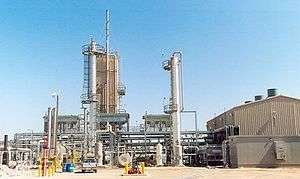National Helium Reserve


The National Helium Reserve, also known as the Federal Helium Reserve, is a strategic reserve of the United States holding over 1 billion cubic meters (109 m3) of helium gas. The helium is stored at the Cliffside Storage Facility about 12 miles (19 km) northwest of Amarillo, Texas, in a natural geologic gas storage formation, the Bush Dome[1] reservoir. The reserve was established with the enactment of the Helium Act of 1925. The strategic supply provisioned the noble gas for airships, and in the 1950s became an important source of coolant during the Cold War and Space Race.
The facilities were located close to the Hugoton and other natural gas fields in southwest Kansas and the panhandle of Oklahoma, plus the Panhandle Field in Texas.[2] These fields contain natural gas with unusually high percentages of helium—from 0.3% to 2.7%—and constitute the United States' largest helium source. The helium is separated as a byproduct from the produced natural gas.
After the Helium Acts Amendments of 1960 (Public Law 86–777), the U.S. Bureau of Mines arranged for five private plants to recover helium from natural gas. For this helium conservation program, the Bureau built a 425-mile (684 km) pipeline from Bushton, Kansas, to connect those plants with the government's partially depleted Cliffside gas field.[3] This helium-nitrogen mixture was injected and stored in the Cliffside gas field until needed, when it then was further purified.
By 1995, a billion cubic metres of the gas had been collected, and the reserve was US$1.4 billion in debt, prompting the Congress of the United States in 1996 to phase out the reserve.[4][5] The resulting "Helium Privatization Act of 1996" (Public Law 104–273) directed the United States Department of the Interior to start selling off the reserve by 2005.[6]
By 2007, the federal government was reported as auctioning off the Amarillo Helium Plant. The National Helium Reserve itself was reported as "slowly being drawn down and sold to private industry."[7] However by early 2011, the facility was still in government hands. In May 2013, the House of Representatives voted to extend the life of the reserve under government control.[8]
See also
References
- ↑ The National Helium Reserve and related media at History.com; retrieved December 09, 2013
- ↑ Pierce, A.P., Gott, G.B., and Mytton, J.W., Uranium and Helium in the Panhandle Gas Field Texas, and Adjacent Areas,Geological Survey Professional Paper 454-G, Washington:US Government Printing Office, 1964.
- ↑ http://www.blm.gov/wo/st/en/info/history/sidebars/energy/managing_the_blm_s.print.html
- ↑ Emsley, John. Nature's Building Blocks: An A-Z Guide to the Elements. Oxford: Oxford University Press, 2001. Page 179. ISBN 0-19-850340-7
- ↑ Guide to the Elements: Revised Edition, by Albert Stwertka (New York; Oxford University Press; 1998; page 24) ISBN 0-19-512708-0
- ↑ http://www.nap.edu/openbook/0309070384/html/index.html Executive Summary
- ↑ Babineck, Mark, "Feds hope a buyer will rise up," 4 August 2007, Houston Chronicle
- ↑ An Ode to Helium, by Gail Collins, New York Times, 4 May 2013
External links
- Federal Helium Program
- www.newscientist.com - Article on Helium.
- http://eolus.phys.northwestern.edu/CM_Theory_Group/Photos/Pages/QFS2009_files/Helium_Shortages_Chan-Richardson.pdf
- New York Times article with map
Coordinates: 35°21′07″N 101°59′28″W / 35.352°N 101.991°W